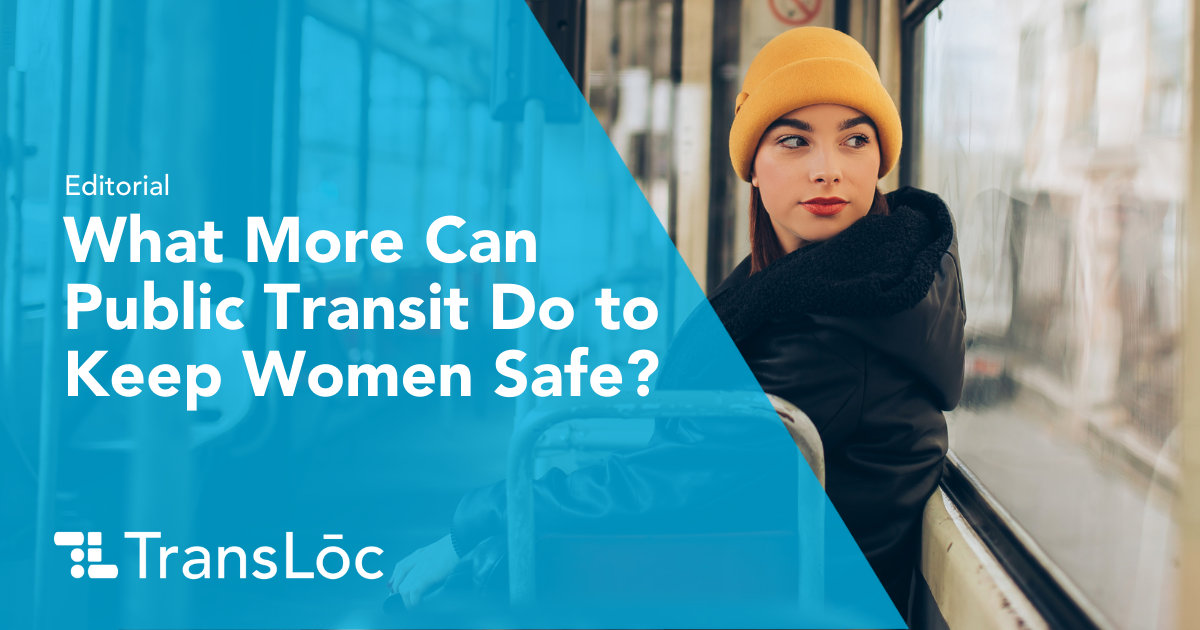
Women have a sixth sense; an awareness developed overtime that keeps us out of harm’s way. Like a computer program running on autopilot, we are constantly scanning our environment to avoid external threats.
Public transit provides freedom of mobility for so many women across the country. Unfortunately, riding public transportation can sometimes be one of those situations where a woman’s sixth sense kicks into high gear. Women are more likely to take extra safety precautions while using public transportation whether it means video calling with a friend, taking note of defining characteristics of the people around you, tucking your hair into the back of your coat, or even grasping a set of keys between clenched knuckles.
First, let’s explore the current safety concerns and limitations that exist for women on public transit, followed by what solutions we can put into practice to create a safer rider experience.
Pink Tax on Transit
In a survey about mobility challenges women face, an alarming 75% reported experiencing harassment or some variation of theft while using public transportation. Of those women, 88% did not report the incident due to a perceived lack of urgency by agencies and authorities to seek justice.
Female respondents combated these threats by dressing differently and avoiding public transit at night. Women who don’t feel safe on public transit often turn to alternative transportation methods like taxis or ridesharing services, adding an average of $26-$50 to their transportation budget per month. The expense is even greater for women who are primary caretakers — they are estimated to have a $100 increase in monthly transit spending compared to the average male rider.
Transportation Bias
One of the biggest causes for contrast in gender experience is that the field of transportation and highway engineering is predominantly male — 77% of graduates from the top transportation and highway engineering institutions are men. This can factor into transit design decisions that inadvertently ignore the safety needs of women. For example, interiors are designed with taller and larger bodies in mind while women of lesser stature sometimes struggle to reach stabilizing bars and straps.
Additionally, while men are taking longer transit trips on average, women are taking shorter, more frequent trips. 65% of women surveyed said they are primarily responsible for household errands like grocery shopping and taking kids to school. A heavy focus on commuting is outweighing the needs of faster and safer short-distance accommodations. Women are still overwhelmingly responsible for childcare, making easy and safe transportation for children a top priority for mothers. Navigating transit systems while lugging around strollers or car seats can be complicated. Transit agencies have an opportunity to create convenient and safe options to untangle this complication while mitigating any unintended bias against female riders.
There are realistic, attainable ways to reduce risk for women in public transportation. It’s not necessarily a matter of how, but when.
Women-Only Microtransit
One of several remedies we can use to create a safer female traveling experience is a women-only transit service. Countries like Japan and Germany have already adopted similar measures with women-only cars on trains. While large-scale implementation would require immense infrastructure, personnel, and financing, microtransit options may be a feasible solution for several safety concerns. Women-only microtransit may help reduce the risk of harassment and theft, offer more frequent and shorter-distance ride options, and create space for female caregivers traveling with children and supplies like carseats and strollers.
Anti-Harassment Campaigns & Safety Education
We can help keep the issue top of mind for riders — and deter perpetrators from harassing passengers — by running advertising campaigns that educate all riders on how to stay safe, recognize inappropriate behavior, and how to effectively report incidents to the proper authorities. Proactive campaigns should discourage offenders while increasing harassment awareness for other riders. The more knowledge that riders have, the more likely they will become active bystanders in the event of an incident — creating a safer environment for female riders.
Increased Surveillance
Measures that utilize existing transit infrastructure are already in place to help maximize safety in public transit settings — sadly, it just doesn’t seem to be enough. Transit agencies can up the ante on existing strategies including increased lighting, security personnel, surveillance cameras, and reliable on-time schedules to reduce time waiting for transit. Additionally, we can implement steeper penalties for offenders. These simple measures can make a big impact when provided in the right quality and quantity.
Ultimately, safer transit equals increased ridership. When women decide against using public transportation for fear of harassment or their personal safety, an entire segment of the population is deprived of mobility while transit agencies lose riders. By implementing strategies such as women-only microtransit, harassment awareness, and increased surveillance, we can work towards a public transit experience where women have the same confidence in safety as the average man.